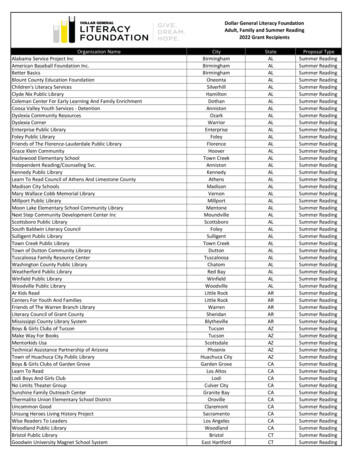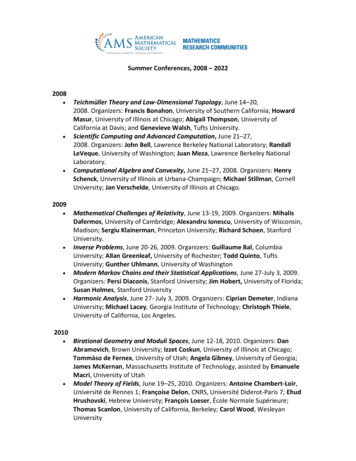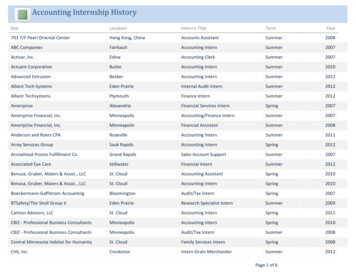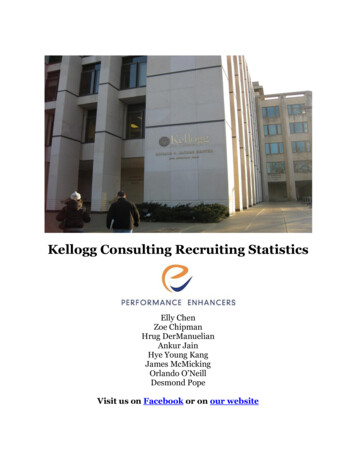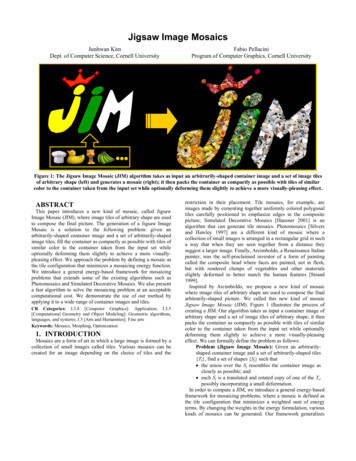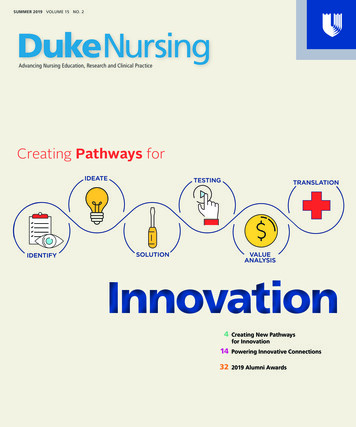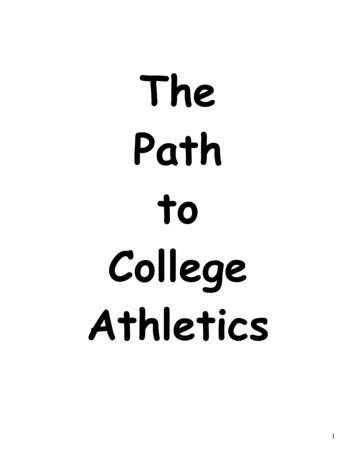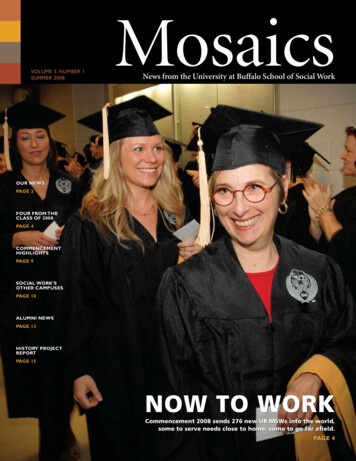
Transcription
MosaicsVOLUME 3, NUMBER 1SUMMER 2008MosaicsNews from the University at Buffalo School of Social WorkOUR NEWSPAGE 2FOUR FROM THECLASS OF 2008PAGE 4COMMENCEMENTHIGHLIGHTSPAGE 9SOCIAL WORK’SOTHER CAMPUSESPAGE 10ALUMNI NEWSPAGE 12HISTORY PROJECTREPORTPAGE 15now to workCommencement 2008 sends 276 new UB MSws into the world,some to serve needs close to home, some to go far afeld.PAGE 4
MosaicsMosaics, the newsletter of the UBSchool of Social Work, is producedthree times a year by the Offce ofUniversity Communications, Divison of External Affairs. August 2008.08-SOC-004.Our NewsAlumni come homehow to be self-protective without operatingMore than 125 alumni and friends attendedfrom a fear base. Faith Hoffman, who hasAlumni Day 2008 on March 27.been instrumental in making the Buffalo VALinda Ray, executive director of thehospital a leading center in identifying andwww.socialwork.buffalo.eduFamily Justice Center of Erie County, gavetreating violent families, provided strate-The University at Buffalo is a premierthe keynote address. She described the rolegies for recognizing domestic violence inresearch-intensive public university, theher multiagency collaboration plays in pro-combat-affected families.largest and most comprehensive cam-viding a single, safe location where victimspus in the State University of New York.of domestic/intimate partner violence canUB’s more than 27,000 students pursuegain access to legal, medical and counselingA big thank-you for feldeducatorstheir academic interests through moreservices and the role social workers play inField educators were honored at a receptionthan 300 undergraduate, graduate andthe collaboration.May 1 at UB’s Jacobs Executive Develop-professional degree programs. Foundedin 1846, the University at Buffalo is aTwo workshops focused on potentiallyviolent clients. Kenneth Duszynski spoke onment Center in Buffalo. This annual eventrecognizes feld educators’ commitmentmember of the Association of AmericanUniversities.EDITORIAL TEAMJessica PerkinsGraduate AssistantSchool of Social WorkBarbara RittnerAssociate Dean for External AffairsSchool of Social WorkJud MeadNewsletters CoordinatorOffce of University CommunicationsLauren MaynardNewsletters EditorOffce of University CommunicationsOne happy crowd (and smart, too)—2008’s student award honoreesFront row, from left: Nicole Fava, Outstanding Student Award (Buffalo campus); ChrisLunsford, Niles Carpenter Award; Ellen Bean, Dena P. Gold Memorial Award; ChristinaDESIGNHowells, School of Social Work Alumni Association Award; Jennifer Willett, Hazeltine T.Celine TanOffce of University CommunicationsCover Photo: Nancy J. ParisiClements Memorial Award; Kristin Cangialosi, Dorothy Lynn Honorary Award; HeatherTighe, Kistopher L. Braselton Memorial Award; Rebecca Green, Terese Eusanio MemorialAward. Back row, from left: Matthew Tice, NASW Award; Maurice Samuel, DREAM Award;Melissa Davies, Thorn and Rose Award; Laura Landry, Julian Sodja Memorial Fund; AllenBethea, Archie W. Swanson Honorary Award. Not in photo: Gabriella McBean, Louisa CielenAward; Eugenia Stevens, Outstanding Student Award (Rochester campus); Charity Lowry,Outstanding Student Award (Jamestown campus); Cathleen Reddy, Outstanding StudentAward (Corning campus).2MOSAICS : SUMMER 2008
FROM DEANNANCY J. SMYTHto UB MSW students, the school and theence on Clinical Supervision sponsored byprofession. The reception drew 100 feldthe National Institute of Drug Abuse. Thereeducators and students.were 176 attendees, most of whom also at-I’m surprised to discover how fewtended preconference workshops. Partici-people realize we have four campuses—the community-based youth developmentpants from the Philippines, China, Ireland,the main campus in Buffalo and off-siteprogram at the Nazareth College Center forNew Zealand, the U.K. and Australia joinedprograms in Jamestown, RochesterService Learning, and Nicole Rizzo, LMSW,practitioners from across the United States.and Corning. We created our off-siteMarie Watkins, MSW, PhD, director ofdirector of the restorative justice program atThe 2008 conference was the mostprograms in response to requests fromChild and Family Services of Erie County,interdisciplinary to date, attracting socialcommunities; a key factor in establish-were honored with the 2008 Outstandingworkers, psychologists, psychiatrists, anding the programs was the lack of a near-Achievement in Field Education Award.counselors in schools, residences and sub-by public MSW program. As a publicStudents nominated 31 feld educators forstance abuse agencies. university, we take our mission of accessseriously, and for each off-site program,the award.SPRING 2008DISTINGUISHED SCHOLARInternational social workSocial work students Matt Tice and JenniferWillett, and faculty member Filomena Critelli attended the 25th Annual Social WorkDay at the United Nations on March 31.Their trip was part of the School of SocialWork initiative to infuse the social workcurriculum with a global focus in socialwork practice.The two students also took part in thefrst global social work student conferenceat Fordham University. The meetings, whichincluded presentations from leading fguresin international social work, provided anopportunity to learn more about the U.N.and about issues related to internationalsocial work.In June, the school hosted the 4thThe Buffalo Center forSocial Research 2008distinguished scholar wasMichael Hogan, Ph.D., NewYork State Commissioner ofMental Health. He lecturedon “Transforming Mental Health in NewYork State.” Hogan served as chair of thePresident’s New Freedom Commission onMental Health. The April 10 event drewan audience of more than 150, includingUB faculty and students and guests fromagencies across Western New York.we decided the need warranted offeringthe MSW there.Therefore it’s with mixed feelings that we now see our last Corningclass graduate. The Corning programhas educated many excellent socialworkers from a wide region, includingPennsylvania. It’s the farthest programfrom our Buffalo campus (130 miles)and is actually much closer to Binghamton than to Buffalo. Our sisterSUNY university at Binghamton hasnow developed an MSW program; itA videotape of the lecture is available forviewing at uished.asp.received accreditation in 2006. ThisFor notifcation of future Buffalo Centerfor Social Research events, contact DeniseFinnan at (716) 829-3991, ext. 101 or atdfnnan@buffalo.edu.Hence my decision that this will be ourInterdisciplinary and International Confer-good news, however, lessened the needfor our continued presence in Corning.last Corning class. I want to thank thestudents, alumni, faculty, staff and feldeducators who made the Corning program so successful. We look forward tocontinuing our relationship, especiallyIn the next issueAt the School of Social Work, we train researchers whocan generate the evidence for evidence-based practice.In the next issue of Mosaics, you will meet a PhDgraduate who is now doing research in the community;an NIH researcher in Washington, D.C.; and a programresearcher with a new approach here in Buffalo. Andour research faculty will talk about service learning andthe hands-on research experience.through our online courses and withMosaics. We will continue to celebrateyour successes.Nancy J. Smyth, PhD, LCSWMOSAICS : SUMMER 20083
Nancy J. ParisiGreat Grads Times FourThe School of Social Work conferred 90 more master’s degrees in 2008 than it did ineach of the two years before. This has been the case every third year since 2002, whenthe frst full cohort of students from the school’s extension programs in Corning,Jamestown and Rochester completed their MSW programs. In the following pages, youwill meet MSW graduates from each of the four campuses. The story beginning onPage 10 describes the MSW extension programs.4MOSAICS : SUMMER 2008
GRADUATION 2008 CHARITY LOWRY - JamestownZeiders. When she arrived at her placement to apprentice as aIt would be somewhat misleading to hold up Charity Lowry asmental health counselor, Lowry says she knew nothing and thatrepresentative of what one can get from the UB MSW program.she considered what she had to learn to be “very scary.” But withBut this is, nonetheless, her story.careful, supportive guidance by Zeiders, she did learn the work.Lowry earned her MSW at the Jamestown extension campus, completing her fnal feld education hours in August. Her“I walked away knowing I could do this,” she says.Her connection with Zeiders will continue as she works to-frst feld placement was as an intern in mental health counselingward her clinical license. “The ‘R’ is gold down here,” Lowry says.with Catholic Charities in Olean, N.Y., where she lives. Less thanShe knows only two LMSW-R social workers in the three-countytwo years later, after having gone to work for Catholic Chari-area where she will be directing Catholic Charities offces.ties as a case manager in the meantime, and after completing aIndeed, Lowry sayssecond placement for the organization, working in emergency-that in the three South-related services in the Jamestown offce, she has now been namedern Tier counties thatdirector of all Catholic Charities’ Southern Tier operations. NiceCatholic Charities serves,progress for a student.the needs are great,She will oversee services in three counties provided by of-underserved and “mostfces in Jamestown (Chautauqua ), Wellsville (Allegany) and thedefnitely underfund-central offce in Olean (Cattaraugus).ed.” But she has goodLowry was working as a parent educator for a small non-resources at hand whenproft in Olean when her boss told her that if she wanted a careershe needs to fll posi-in the feld, she should get an MSW. She is a single workingtions: her successor asmother so the full-time program in Buffalo wasn’t an option;the Olean intensive caseentering the part-time program in 2005, she made the 50-minutemanager will be Nicholecommute to Jamestown with two Olean classmates. She remem-Cerra, MSW ’08 (Cerrabers many “white knuckle” winter nights on the road over theappeared in the spring is-three years.sue of Mosaics), who hasBy the time Lowry was assigned to her frst feld placement, she was working as a trainer with a county employmentbeen working in the sameoffce as a supportive caseCHARITY LoWRYprogram called Cattaraugus One-Stop. When a case managermanager; Matt Wenke, MSW ’08, will step into Cerra’s positionposition opened at Catholic Charities in fall 2006, she appliedin the Olean offce; and Jackie Joy, MSW ’08, who was Lowry’swithout telling anyone in her internship because she didn’t wantclassmate in Jamestown, has accepted a therapist position therespecial consideration. She got the job, which involved managingwith Catholic Charities.the cases of adolescents with mental illness who are referred by“There is great talent coming out of UB,” Lowry says, wear-county social services as having needs classifed as “intensive,”ing her Catholic Charities hat. “And this area is starved.” Shethe middle of three levels of intervention, requiring at least oneplans to talent-scout the next cohort of Jamestown extensioncontact per week.students when they start the three-year program this fall.“I knew Catholic Charities was a ft for me,” she says.Now that she’s fnished her own three-year program, withThe job put Lowry on the road to see her clients in their ownher master’s in hand, with a new complement of skills, a newsurroundings at home, at their counseling appointments or atnetwork of friends and a job she can use to improve lives acrossschool during free periods. She assessed their needs and coordi-three counties, Lowry can stop to breathe occasionally.nated services with the goal of keeping them out of the hospitaland at home, if possible.One of the reasons she was comfortable with CatholicCharities was her experience working with feld educator Jesse“It was a challenge. I’m a single mom and I was workingfull-time. But I had an amazing family behind me,” she says.That she is already director of an important social servicesprovider is in keeping with Lowry’s assessment of herself. SheMOSAICS : SUMMER 20085
GRADUATION 2008 says she knew she had administration in her future, if not quitement tool to use with kids at intake, at mid-stay and when theythis soon.left a residence. McLoud and his partner reduced the terminol-“Where I am now all goes back to my frst internship,” shesays. “I owe it all to the MSW program.” —J.M.ogy of diagnoses and symptoms to a 15-item checklist of mostcommon behavioral problems encountered with Glove Houseresidents.JASON MCLOUD - CorningTen years ago when Jason McLoud, with his brand-new bach-propriate for the behavior problems on their checklist in order toelor’s degree in psychology, started traveling from small town tomore systematically coordinate assessment and programming.small town in Steuben County, N.Y., checking on at-risk adoles-His initial feld placement had been in a Glove Housecents as a county preventive services caseworker, he’d had someresidence, learning the fundamentals of counseling under thetraining in interviewing and not much more than that.supervision of Kevin Murphy, the organization’s director ofHe learned on the job—and he learned well, although hesocial work. During the frst half of the placement, Murphy hadworries about cases he could have handled better during thisMcLoud simply establish himself as a presence in the house heeducation on the road. After seven years, he was promoted towas assigned to, watching and getting to know the 10 residentssupervisor of his unit, responsible for nine caseworkers provid-who ranged in age from 9 to 18, and letting them get to knowing PINS diversion and child protection services for the northernhim. For the second half of the placement, he would have beenhalf of the sprawling, mostly rural county.an understudy to the house social worker, but the social workerMcLoud had just started the UB MSW program at theleft and McLoud was in the deep end on his own. “It worked out,”Corning extension campus, so he spent three more years on thehe says. “It was a decent house with a good combination of kids.”road, traveling to class and to his feld placements in Elmira,He especially values the skills he learned in cognitiveplaying the theories he was studying against the realities of hisbehavioral therapy, for which he credits “some class work and ajob. He took what he learned at night to work in the morning;ton of work in the feld,” and he says he might contemplate doingclass discussion extended into discussions with co-workers.private therapy eventually.“It really worked out for me,” he says about the MSW pro-McLoud is committed to his work in the county—“I’m intogram. “It gave me a lot of ideas about how to improve function-what I do”—and the county has been committed to him. Theing in my unit.” One that he’s working on now is developing adeputy commissioner of social services arranged for him to takecaseworker model to address defciencies he sees in on-the-jobUB courses at Corning as a nonmatriculated student some yearseducation.ago and supported his tuition during the MSW program he just“We learn procedures just by being here,” he says. “Welearn by trial and error, we learn from our peers—but they don’talways know the best way.”McLoud guesses that few, possibly none, of his caseworkers could clearly describe the role of a caseworker—they knowcompleted.What the investment bought the county is a manager whodescribes himself as “totally energized” by the program. “I reallyfeel smarter than I was,” McLoud says.He also took away a heightened appreciation for some-how to do the work but they haven’t had the beneft of learningthing he already knew. When Buffalo-based faculty memberfrom a formal model of casework. “It’s surprising. Social servicePeter Sobota, MSW ’85, lectured on the role of social workersdepartments are very bureaucratic but we don’t have a manualas deviants, standing apart in order to see from the perspectivefor how to do this work.”of the oppressed, he hit the heart of the matter for McLoud, anSystemizing services was the subject of McLoud’s concluding feld placement with Glove House in Elmira, N.Y., where heand a classmate worked on a manual of interventions for useex-rock-’n’-roller and self-described rebel. “That’s totally whatI’m all about.”Now he’d like to spread the beneft. He says that, ideally,with the adolescent population in the organization’s residentialhe’d teach all his caseworkers what he learned in the MSWfacilities.program. They could then better teach the parents they interactThe Glove House clinical director wanted a better assess-6They also compiled activities and other interventions ap-MOSAICS : SUMMER 2008with, who could then better teach their children. In McLoud’s
GRADUATION 2008 vision, his MSW education will radiate out from the countyoffces in Bath, producing incrementally better outcomes for thechildren and adolescents his department serves. —J.M.really fnding coherence in it.Keefe expected to gravitate toward older students in theMSW program but discovered that age wasn’t a factor at all indeveloping friendships.TOBI KEEFE - BuffaloShe was almost willfully ignorant of the world of socialWhat better occupation for a social worker in the few weekswork when she started because her father had told her, whenbetween receiving her MSW and starting a job that requiresshe was young, at a time when there were many fewer profes-licensure than working the phone to make sure everything gotsional opportunities available to women, that whatever she did,done to secure a seat at a licensing exam in July.she shouldn’t be a social worker because she was too much of aTobi Keefe, MSW ’08, tracked her paperwork through UBand then talked it through the state Offce of the Professions until she had the authorization number she needed. She spent herfrst career in sales, so she knows how to use the telephone.bleeding heart. Now she knows that the technical term for bleeding heart is compassion.Her father did not raise a shrinking violet. When Keefestarted in sales, it was a man’s feld. She says that two of theIn her new career, she will combine that well-developed skillhardest things she did in sales were getting in, and getting out.and the new clinical skills she developed in the MSW program inShe fnally had a conversation with a social worker friend whoa position as a member of the Veterans Administration nationalpushed her to seriously consider study for an MSW. She lookedsuicide prevention hotline team, based in Canandaigua, N.Y.at programs in Rochester—she and her husband live in nearbyKeefe says that in all her years in sales, which she was goodVictor, N.Y.—including UB’s Rochester extension program, andat, she was teased by something that didn’t quite ft the role,fnally settled on UB in Buffalo because she wanted to completesomething that felt awkward. Now she knows what it was. “Inthe program in two years.social work, we call it passion,” she says.She spent two days a week in Buffalo, staying with a friend’sWhen she was fnishing the program, at the threshold ofdaughter who was in medical school, and two days in the feldprofessional practice, one of her professors told her that she hadnearer home, thanks to placements arranged by Shirley Reiser,found her voice. She was ready.MSW ’76, coordinator of the UB Rochester extension. “A lot ofTwo years before,Keefe had felt a little lostAmong the circumstances that aligned was a foundation-in a feld of study in whichyear feld placement in an inpatient acute mental health site ateveryone but her seemedthe Canandaigua Veterans Affairs Medical Center. It ft her inter-to know the meaning ofest in adult mental health. Keefe had the chance to see a consider-words like decompensate.able variety of patients and work with a multidisciplinary mentalShe hadn’t run into thathealth team in a system that was its own network of services.one in sales. She knew howIn her second-year feld placement in an outpatient mentalto “do” school, but the vol-health clinic at Clifton Springs Hospital in Clifton Springs, N.Y.,ume of work was dauntingKeefe developed mental health counseling skills and learned toat frst. It took a semesterperform bio-psycho-social assessments. She says that time pres-for her to understand whatsure—90 minutes total, 60 minutes with the client—made the as-social work was about, butsessments challenging. Those skills will be critical in her new jobthen she got it—and shewhen Keefe is assessing and sorting calls coming from anywhereliked what she understood.in the country, determining as soon as possible whether whatEarlier in her career, she’dshe’s hearing is an imminent problem.completed a master’s proToBI KeeFethings worked out really well,” she says.“I love working with veterans,” she says. The Iraq Wargram in human resourceshas put veterans’ issues in the news today, but the populationdevelopment without everincludes elderly Second World War vets and aging Vietnam WarMOSAICS : SUMMER 20087
GRADUATION 2008 vets. Keefe says she expects to gain additional clinical perspectivesome only an hour, because it demonstrates a lack of respect forin her work with the VA.those communities and those people,” Matt says. He hopes heShe is joining a program that was started in August 2007and had handled 37,200 calls and effected more than 720 rescuesin its frst eight months according to an April article in the Newcan use this lesson in the next stage of his development as a socialworker.Now that he has his degree, Matt hopes to fnd a part-timeYork Times. After a shakedown year, the hotline is adding licensedposition—he’ll keep his teaching job—working with children inMSW staff to bolster its operations. Keefe was hired provision-an agency somewhere around Rochester. He would like to de-ally. She passed her frst test: getting a seat at the licensing exam.velop a program in which he could guide the same group for anThen she passed the real test. Now it’s Tobi Keefe LMSW. —J.M.entire year. He’d work with them on needs and support strengthsduring the school year and during the summer he’d expand theirMATT BUDD - Rochesterwork into their own community and beyond. But not for just aIn each of the past two years, Matt Budd visited cultures veryquick visit.different from the one he knows in Rochester, N.Y., looking atthem through the lens of a social work student. Last year he wenthomework on the MSW selection available to him. He decidedto Kenya on a trip organized by the University of North Carolinathat UB offered the best program, and he couldn’t improve onSchool of Social Work. This year he visited the Dominicanthe location. “It all fell into place at the right time, because theRepublic on another service learning expedition funded by theprogram starts every three years and that happened to be theschool where he teaches.right time,” he says. “With Buffalo having such a strong standingMatt was studying in theRochester extension MSWFor the immediate future, Matt will incorporate the skillsand knowledge of his social work education and feld experiencesing fourth-grade students at theinto his classroom. In both his internships—his frst was at Berk-private Harley School in Rochestershire Farm Center and Services for Youth, and his second wasduring the day.with St. Joseph’s Villa—he worked with a very different group ofway he hadn’t expected: they sensitized him to the plight of poorkids than his well-advantaged fourth graders.At Berkshire Farm, he spent three days a week interactingwith kids and helping them understand and exhibit appropriatepeople as mere objects of interest.social responses and to develop skills at making safe choices. AtIn Kenya, Matt visited manySt. Joseph’s Villa, where the agency focuses on a strength-basedplaces but only for brief stops. Heapproach in working with children and families, Matt says, “Wesaw life in rural areas and in cities.help them empower themselves and fnd resources and supportAnd at the end of each day, he andwithin their community, so that eventually the client becomeshis colleagues adjourned to a hotelsuccessful without your support.”where they were surrounded byMATT BUDDas an MSW program, no question, that’s where I wanted to go.”program at night and teach-The trips educated him in afellow Americans.On his second trip, he got it. Assisting a community wouldMatt says he may go back to school for more but frst hewants to complete the incorporation of what he just learned intohis teaching and his life.require immersion and commitment to the people living there.“I think the MSW has been a great building block, and IAs much as his travels taught him about communities very dif-hope it’s not where I stop,” he says. “I want to take everythingferent from his own, Matt was left with a stronger impression ofI’ve gained and learned and continue to build on it. I feel like it’sthe negative aspect of this type of trip. He realized that while thegiven me so many options, even things like going into research,people he was seeing appreciate support from foreign groups andwhich I would never have thought of doing before.”are open to visitors, they aren’t living sculptures.“They don’t like it when groups come in for short periods,8Matt chose to get a UB MSW in Rochester after doingMOSAICS : SUMMER 2008He calls the confdence he now feels going into interviewswith a UB MSW in his pocket, “priceless.” —Jessica Perkins
C O M M E NC E M E N T 2 0 0 8(Above) Dean Nancy Smyth welcomes this year’s proud graduates, their families and friends to the School of Social Work’s73rd commencement.(Above right) How good does it feel to fnish? Graduatescelebrate their accomplishments with friends they’ve madealong the way.(Below) Selected by the faculty as one of this year’s marshals,Barbara Rittner, associate dean for external affairs, leads thefaculty into Commencement 2008.D O C TO R S O F S T Y L EIn 2006, social work doctoral students asked why UB academicrobes were basic black. (So dull.) Being social workers, the schoolanswered Why, indeed! and designed these elegant robes. (Don’task, act.) A year later, the whole university adopted the new look.Now all UB doctoral graduates walk in high style.Photos on this page: Nancy J. ParisiMOSAICS : SUMMER 20089
Photos: Rose MattreySpreading the beneftExtension programs train social workers who are needed where they live.By Judson MeadThe two-year UB MSW program is conducted at a30,000-student university in a metropolitan area withfull-time, many in social services positions, some in other feldsa population of more than 1.1 million. The pace, thewho are planning career changes. Students complete the fullhours, the parking, the feld placements, the conversations areMSW curriculum in three years, studying year round and tak-peculiar to that place.ing classes and performing their feld internships at night andSo it is with the School of Social Work’s MSW extensionon weekends. Buffalo-based social work faculty members teachprograms in Jamestown, Corning and Rochester—and that’ssome 60 percent of the extension courses, adjunct faculties oftheir difference. The settings are different from Buffalo, and fromlocal practitioners the balance. Admission criteria and academiceach other; the students have different relationships with theprogress requirements are the same in the extension programs asprograms; and the populations they work with—professionallyin the Buffalo MSW program.and as master’s students—may be quite different from the onesin Buffalo.The three extension programs, which are now only two withUnlike the Buffalo student, almost any Corning student—ranging from probation workers to child protective servicescaseworkers—could present cases from their weekday work forthe closing of the Corning program this August, just graduatedclass discussion. Jason McLoud, a social services supervisor, saystheir third cohort of students—Charity Lowry, Jason McLoudthat these sessions fed right back into their jobs: social serviceand Matt Budd among them (see story, Pages 4-8). Begun inworkers already established in careers, listening and brainstorm-1999 and expanding on experimental extension courses UB hading about their work while they studied the next level of skills.been offering in Corning for a few years, the programs enrollclasses of about 30 once every three years.Students move through the three-year programs together10The extension MSW is designed for people who workAnd the stories from such roundtables in Corning andJamestown classrooms might sound foreign to Buffalo students,even the experienced social workers among them. Their Corningand then the cycle begins again. Classes that graduated in 2002,and Jamestown cousins live and study in a social services envi-2005 and this year account for almost 300 MSWs, many ofronment that is shaped by distance and low population density.whom work in Southern Tier and central New York counties andIn an urban setting, there may be serious poverty and arepresent a signifcant homegrown cadre of master’s-level socialgreat need for services, but there are many services and everyoneworkers that wouldn’t be available in these areas without the UBis fairly close—and fairly visible. In a rural county—in Alle-programs.gany County, for instance, with less than half the population ofMOSAICS : SUMMER 2008
Amherst, N.Y., spread across an area as large as Erie County—additional challenge of fnding places that can accept interns whowhat services exist might be located in one or two towns, and thecan work only at night and on weekends. With more studentsneeds across the countryside are often invisible simply becausecoming from rural areas, placements close to their home areno one is looking.complicated by the absence of licensed social workers to super-Jamestown program coordinator Elaine Hammond saysthat in Chautauqua, Cattaraugus and Al
SUNY university at Binghamton has now developed an MSW program; it received accreditation in 2006. This good news, however, lessened the need for our continued presence in Corning. Hence my decision that this will be our last Corning class. I want to thank the students, alumni, faculty, staff and feld educators who made the Corning pro
